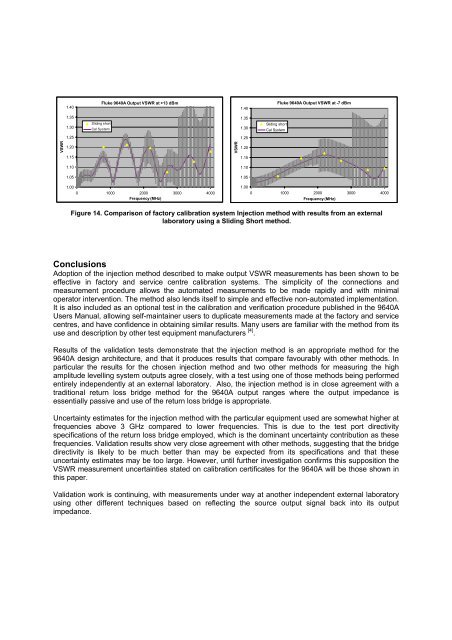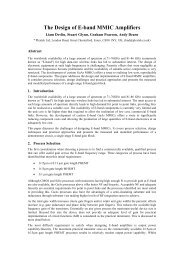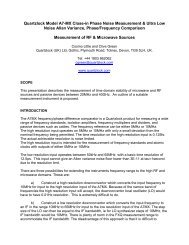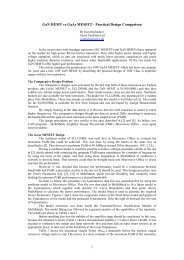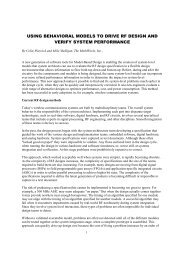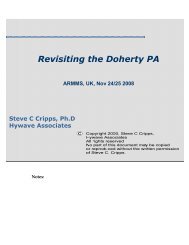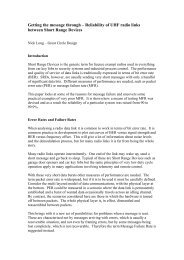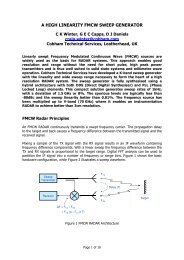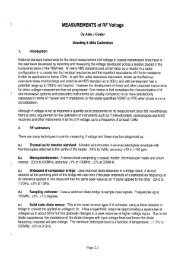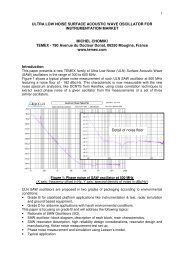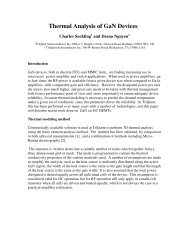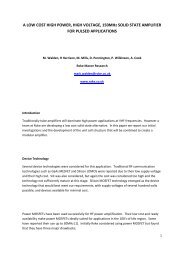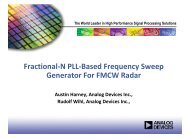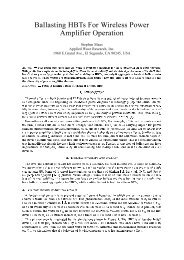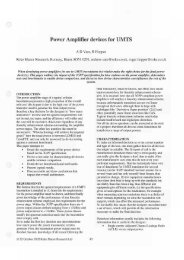Measuring Output VSWR For An Active Levelled Source
Measuring Output VSWR For An Active Levelled Source
Measuring Output VSWR For An Active Levelled Source
Create successful ePaper yourself
Turn your PDF publications into a flip-book with our unique Google optimized e-Paper software.
1.40<br />
Fluke 9640A <strong>Output</strong> <strong>VSWR</strong> at +13 dBm<br />
1.40<br />
Fluke 9640A <strong>Output</strong> <strong>VSWR</strong> at -7 dBm<br />
1.35<br />
1.30<br />
Sliding short<br />
Cal System<br />
1.35<br />
1.30<br />
Sliding short<br />
Cal System<br />
1.25<br />
1.25<br />
<strong>VSWR</strong><br />
1.20<br />
<strong>VSWR</strong><br />
1.20<br />
1.15<br />
1.15<br />
1.10<br />
1.10<br />
1.05<br />
1.05<br />
1.00<br />
0 1000 2000 3000 4000<br />
Frequency (MHz)<br />
1.00<br />
0 1000 2000 3000 4000<br />
Frequency (MHz)<br />
Figure 14. Comparison of factory calibration system Injection method with results from an external<br />
laboratory using a Sliding Short method.<br />
Conclusions<br />
Adoption of the injection method described to make output <strong>VSWR</strong> measurements has been shown to be<br />
effective in factory and service centre calibration systems. The simplicity of the connections and<br />
measurement procedure allows the automated measurements to be made rapidly and with minimal<br />
operator intervention. The method also lends itself to simple and effective non-automated implementation.<br />
It is also included as an optional test in the calibration and verification procedure published in the 9640A<br />
Users Manual, allowing self-maintainer users to duplicate measurements made at the factory and service<br />
centres, and have confidence in obtaining similar results. Many users are familiar with the method from its<br />
use and description by other test equipment manufacturers [4] .<br />
Results of the validation tests demonstrate that the injection method is an appropriate method for the<br />
9640A design architecture, and that it produces results that compare favourably with other methods. In<br />
particular the results for the chosen injection method and two other methods for measuring the high<br />
amplitude levelling system outputs agree closely, with a test using one of those methods being performed<br />
entirely independently at an external laboratory. Also, the injection method is in close agreement with a<br />
traditional return loss bridge method for the 9640A output ranges where the output impedance is<br />
essentially passive and use of the return loss bridge is appropriate.<br />
Uncertainty estimates for the injection method with the particular equipment used are somewhat higher at<br />
frequencies above 3 GHz compared to lower frequencies. This is due to the test port directivity<br />
specifications of the return loss bridge employed, which is the dominant uncertainty contribution as these<br />
frequencies. Validation results show very close agreement with other methods, suggesting that the bridge<br />
directivity is likely to be much better than may be expected from its specifications and that these<br />
uncertainty estimates may be too large. However, until further investigation confirms this supposition the<br />
<strong>VSWR</strong> measurement uncertainties stated on calibration certificates for the 9640A will be those shown in<br />
this paper.<br />
Validation work is continuing, with measurements under way at another independent external laboratory<br />
using other different techniques based on reflecting the source output signal back into its output<br />
impedance.


